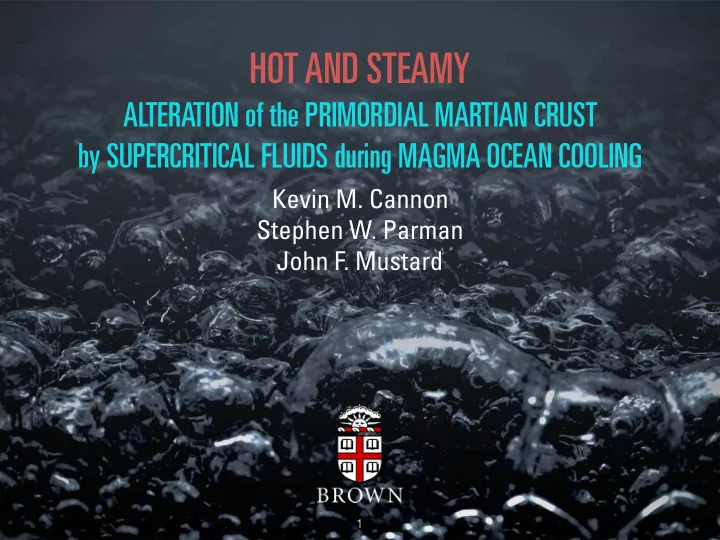

HOT AND STEAMY ALTERATION of the PRIMORDIAL MARTIAN CRUST by SUPERCRITICAL FLUIDS during MAGMA OCEAN COOLING Kevin M. Cannon Stephen W. Parman John F. Mustard 1
Crustal alteration: x-y extent (Mustard et al. 2008; Carter et al. 2013) from Carter et al. 2013 CRISM detections of alteration minerals Detections/Observations/deg 2 2
Crustal alteration: z extent (Sun and Milliken 2015) modi fj ed from Sun and Milliken 2015 3
From whence came Mars’ clays? (Ehlmann et al. 2012; Tornabene et al. 2013; Carter et al. 2015) from Ehlmann et al. 2012 4
Magma ocean evolution (Abe 1993; Elkins-Tanton et al. 2005; Elkins-Tanton 2008) 5
Magma ocean evolution (Abe 1993; Elkins-Tanton et al. 2005; Elkins-Tanton 2008) “In all the models presented for Earth and Mars the final atmospheric pressure from degassing a magma ocean is close to the critical point of water , indicating the likelihood of supercritical fluids on the surface of planets as they cool, and raising the question of their effect on the composition and weathering of the earliest basaltic crusts.” - Elkins-Tanton, 2008 6
1 mm Starting material SiO 2 MnO 50.57 0.3 TiO 2 MgO 1.04 8.31 Al 2 O 3 CaO 11.92 9.5 Cr 2 O 3 Na 2 O 0.19 3.98 FeO K 2 O 13.83 0.36 10% Gl 14% Olv 54% Plag 22% CPX 7
Experiment design 20°C/km Super- critical Liquid Vapor 8
X-ray diffraction Supercritical Liquid Geotherm Unaltered
X-ray diffraction Supercritical Liquid Geotherm Unaltered 12.6 Å 10 Å
VNIR spectra M-OH H 2 O Fe 2+
VNIR spectra 1.91 μ m 2.34 μ m
Unaltered: SE imaging (20 kv, 4 mm WD) 100 μ m 13
Liquid (325°C, 300 bar) 100 μ m 14
Liquid (325°C, 300 bar) 100 μ m 15
Supercritical (425°C, 300 bar) 100 μ m 16
Supercritical (425°C, 300 bar) 100 μ m 17
Unaltered: EMPA elemental maps Glass Olivine Si Al Ca Plag CPX 100 μ m 18
Liquid (325°C, 300 bar) Supercritical (425°C, 300 bar) 100 μ m Si Al Ca 19
Conclusions W e observe significant phyllosilicate formation in the vicinity of the H2O critical point after just 2 weeks, but none at 100°C at 5km depth-equivalent . 20
Conclusions There is a change in alteration assemblage going from the liquid to the supercritical field, with a transition from smectite to illite and possible increase in alteration extent . 21
Conclusions The final stages of magma ocean cooling should have driven significant crustal alteration, but the duration and depth remains unclear. modi fj ed from Sun and Milliken 2015 22
Open questions What is the volumetric extent of crustal alteration? 23
Open questions What is the volumetric extent of crustal alteration? Is there really a link between phyllosilicates and climate ? 24
Conclusions W e observe significant phyllosilicate formation in the vicinity of the H2O critical point after just 2 weeks, but none at 100°C at 5km depth-equivalent . There is a change in alteration assemblage going from the liquid to the supercritical field, with a transition from smectite to illite and possible increase in alteration extent . The final stages of magma ocean cooling should have driven significant crustal alteration, but the duration and depth remains unclear. 25
Extras 26
Total impact melt ~5x10 7 km 3 Martian crust, outer 15 km 2.2x10 9 km 3 (Rivera-Valentin and Craig 2015) 27
Recommend
More recommend